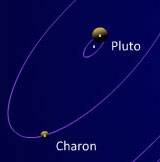The Planet Neptune

Neptune comparison to Earth
Neptune
Neptune is the eighth closest planet to the Sun and is (since the relegation of Pluto) the last Planet in the Solar System. It is similar in size and composition to Uranus with a diameter of 49,000km and a mass of over 17 times that of Earth.
The Longest Year
Uranus orbits the Sun once very 165 years at about 4500 million km. This is 30 times the distance from the Sun to the Earth which means that the strength of sunlight at Neptune is 1% of its strength at Earth. Neptune spins on an axis with a tilt of 28 degrees, which is quite similar to that of the Earth, every 16 hours.
Cold and Windy
Unlike Uranus' almost completely bland cloud layer, Neptune's weather systems are more pronounced with great dark spot storm systems being seen in the southern and northern hemispheres and other visible banding. Wind speeds of up to 600m/s have also been observed. Due to its great distance from the Sun, it is not surprising that the planet is one of the coldest with temperatures of -220 degrees C in the upper atmosphere. The core is thought to be at around 5200 degrees C.
Neptune's Rings
Neptune has a ring system comprised of three main rings with radii between 63,000 km and 42,000km which appear to have a clumpy structure in which they form arcs rather than complete rings. It is believed that gravitational effects from Neptune's moons may cause the clumping.
Moons - Triton
Uranus has 13 known moons of which Triton (2700km diameter) is the most significant. The next largest moon, Proteus, is only 420km in diameter. Triton is the only large moon to orbit in retrograde (e.g. in the opposite direction to most orbits) and is thought to be a captured object rather than created in orbit. It has a very thin atmosphere of Nitrogen, Carbon Dioxide and methane. Although it has a surface temperature of around -230 degrees C, it is thought to be geologically active with cryovolcanism (low temperature volcanoes) producing eruptions of water and ammonia which freeze to form complex valleys and ridges.
Neptune and Man
Neptune is invisible to the naked eye and was unknown to the ancients. It was first discovered when astronomers noticed anomalies in the orbit of Uranus and suggested that an as yet undiscovered planet could be the cause. In 1846 Neptune was observed near the position predicted by Urbain Le Verrier. This was the first planet to be discovered by mathematical prediction. Le Verrier proposed the name Neptune (Roman god of the sea) for the planet since it was in keeping with naming planets after Roman deities (other than Uranus which is Greek).
To date Neptune (like Uranus) has been visited only once - again by the Voyager 2 spacecraft. The fly-by occurred in 1989 and resulted in many discoveries including Neptune's weather systems, rings and 6 more moons. It also provided an accurate measurement of Neptune's mass which allowed discrepancies in the orbits of Uranus and Neptune to be solved.
There are currently no missions planned to visit Neptune, since the Neptune Orbiter and Probe mission was dropped in favour of the Uranus Orbiter and Probe mission.
Voyager at Neptune
Planets |
Dwarf Planets |






